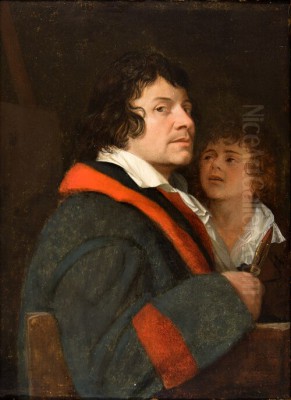
Georges Michel (1763-1843) stands as a significant yet often historically understated figure in the evolution of French landscape painting. Born in Paris, he navigated the tumultuous artistic and political landscape of the late 18th and early 19th centuries, developing a style deeply rooted in observation yet profoundly influenced by the past. Though largely unrecognized during his lifetime, his dedication to depicting the unadorned nature surrounding his native city positions him as a crucial precursor to the celebrated Barbizon School, paving the way for a more direct and naturalistic approach to landscape art in France.
Early Life and Artistic Awakening
Georges Michel entered the world in Paris in 1763, into a family of modest means. His father was employed at the bustling Les Halles market, a far cry from the aristocratic circles that often nurtured artistic talent in that era. Michel's formative years, partly spent on a farm near Saint-Denis, instilled in him a deep appreciation for the rural environment and the rhythms of the countryside. This early connection to nature would become the bedrock of his artistic practice throughout his life.
His formal artistic training began around 1775 under the tutelage of a history painter named Leduc. However, the young Michel quickly demonstrated a stronger affinity for the direct study of landscape than for the grand historical narratives favored by the French Academy. He gravitated towards sketching outdoors, capturing the immediate impressions of the fields, skies, and villages around Paris. This preference for plein air study, even if the final works were completed in the studio, marked him as distinct from many contemporaries still adhering to classical landscape conventions.
The Dutch Masters' Enduring Influence
A defining characteristic of Michel's art is its profound debt to the 17th-century Dutch Golden Age landscape painters. He developed an immense admiration for masters such as Jacob van Ruisdael and Meindert Hobbema. From Ruisdael, Michel absorbed a sense of nature's dramatic power, evident in his treatment of turbulent skies, cloud formations, and the interplay of light and shadow across expansive terrains. Hobbema's influence can be seen in Michel's frequent depiction of rural motifs like windmills, country roads, and detailed renderings of trees and foliage.
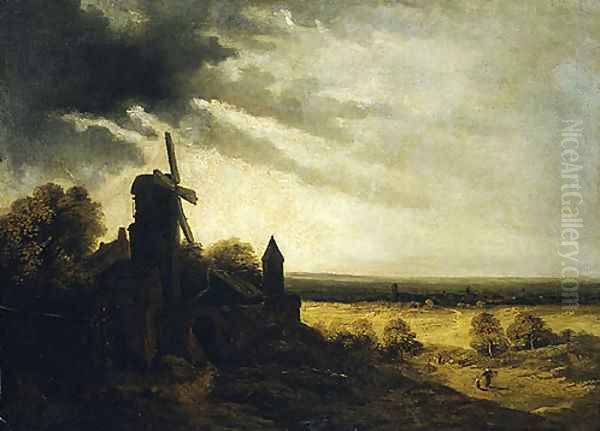
Michel's connection to Dutch art was not merely one of passive admiration. For a period, he worked professionally as a restorer and copyist, specializing in Dutch and Flemish paintings, including assignments for the Louvre Museum. This hands-on experience provided him with intimate technical knowledge of their methods – their glazing techniques, compositional strategies, and approaches to capturing atmospheric effects. This deep immersion undoubtedly refined his own skills and reinforced his stylistic inclinations, setting him apart from the prevailing Italianate landscape tradition in France. Other Dutch masters like Aelbert Cuyp, with his luminous pastoral scenes, or Jan van Goyen, known for his tonal atmospheric studies, likely also formed part of the visual library Michel drew upon.
The Parisian Environs as Muse
Unlike artists who sought inspiration in the idealized landscapes of Italy or the dramatic scenery of the Alps, Michel found his primary subject matter in the immediate vicinity of Paris. He dedicated his career to painting the landscapes of the Île-de-France region, particularly the areas around Montmartre (then a rural hilltop village dotted with windmills), the plains of Saint-Denis, and the banks of the Seine. His canvases capture the specific character of this region – its rolling fields, winding paths, humble cottages, and, above all, its expansive, ever-changing skies.
His works often convey a sense of rustic tranquility and romanticism, but without overt idealization. He depicted the familiar, sometimes mundane, aspects of the local countryside, elevating them through his focus on light and atmosphere. Windmills became a recurring motif, standing sentinel against dramatic cloudscapes. He was particularly attuned to meteorological phenomena, often incorporating stormy weather, rainbows, and shafts of sunlight breaking through clouds, lending his scenes a dynamic and sometimes brooding quality. This focus on the local and the specific was a significant departure from the generalized, classical landscapes favored by the Academy.
Artistic Style and Technique
Michel's style is characterized by its directness and naturalism, tempered by the dramatic sensibilities inherited from his Dutch predecessors. He employed a relatively somber palette, often dominated by earthy browns, greens, and low-key blues, punctuated by highlights of white or yellow to capture the effects of light. His brushwork could be vigorous and expressive, particularly in his rendering of skies and foliage, suggesting a rapid execution aimed at capturing fleeting atmospheric conditions.
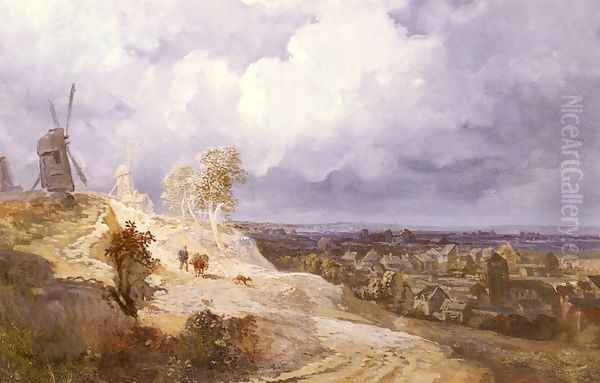
He worked in both oil and watercolor, using the latter perhaps for preparatory studies or more intimate works. His compositions often feature low horizons, emphasizing the vastness and dramatic potential of the sky, which frequently occupies a significant portion of the canvas. The strong contrasts between light and shadow (chiaroscuro) are a hallmark of his work, creating depth and a sense of drama even in seemingly simple rural scenes. While grounded in observation, his paintings possess an imaginative quality, a personal interpretation of the landscape rather than a purely topographical record. This blend of observation, Dutch influence, and personal expression defines his unique artistic signature.
A Career on the Margins
Despite his talent and distinctive vision, Georges Michel remained largely on the periphery of the official art world throughout his career. While he did exhibit works at the Paris Salon intermittently between 1791 and 1814, he failed to achieve significant recognition or critical acclaim. The prevailing taste, heavily influenced by Neoclassicism and figures like Jacques-Louis David, favored historical subjects and idealized landscapes over Michel's more rugged, naturalistic, and Dutch-inspired scenes. His style may have been perceived as lacking the finish and grandeur expected by the Academy and its patrons.
To support himself, Michel relied on his work as a restorer and copyist. He also benefited from the patronage of Baron d'Ivry, a collector who supported his work for a considerable period and commissioned copies of Dutch masterpieces. This relationship, however, reportedly ended around 1830 due to political disagreements, likely related to the July Revolution. Following this break, Michel seems to have retreated further from public life, living in relative obscurity and solitude, particularly in his later years. His lack of commercial success and integration into the mainstream art establishment contributed to his being largely forgotten shortly after his death.
Collaboration and Artistic Connections
While often described as a solitary figure, Michel did engage in some collaboration. Around 1807, he is known to have worked on paintings jointly with fellow artists Jean-Louis Demarne and François-Jacques Swebach (also known as Swebach-Desfontaines). Demarne was known for his landscapes with figures and animals, often in a style reminiscent of Dutch and Flemish genre scenes, while Swebach specialized in battle scenes and depictions of horses. These collaborations, occurring during a period of stylistic transition for Michel, might reflect shared artistic interests or market strategies.
His primary artistic connections, however, remain his teachers, Leduc and Nicolas-Antoine Taunay. Taunay, himself a landscape and genre painter who had achieved considerable success, likely provided Michel with further exposure to different landscape traditions, including the Dutch and Flemish schools he so admired. While Michel forged his own path, these early instructional relationships were crucial in providing him with foundational skills and exposure to the artistic currents of his time.
Forerunner of the Barbizon School
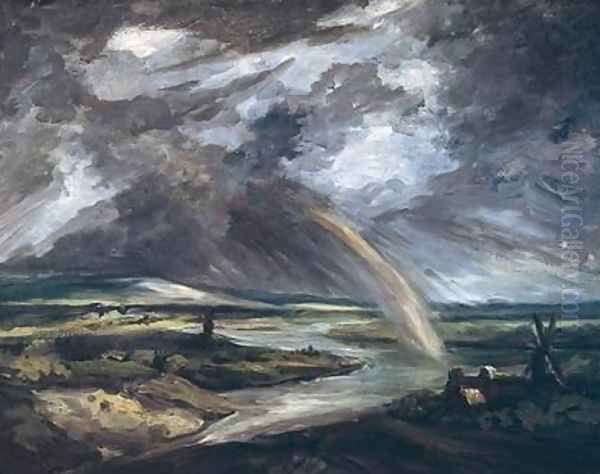
Georges Michel's most significant historical contribution lies in his role as a precursor to the Barbizon School. Active decades before painters like Théodore Rousseau, Jean-François Millet, Charles-François Daubigny, Constant Troyon, Narcisse Virgilio Díaz de la Peña, and Jules Dupré gathered in the village of Barbizon to paint the Forest of Fontainebleau, Michel anticipated many of their core principles. His commitment to painting the local French landscape, his emphasis on direct observation (even if supplemented by studio work), his fascination with atmospheric effects, and his deep engagement with the 17th-century Dutch naturalistic tradition all foreshadowed the Barbizon ethos.
The Barbizon painters sought to break free from the constraints of Neoclassical idealism and paint nature truthfully, often focusing on humble rural scenes and the effects of light and weather. Michel was already doing this in the environs of Paris long before the Barbizon group formally coalesced in the 1830s and 1840s. He demonstrated that the French landscape itself, unadorned and familiar, was a worthy subject for serious art, independent of historical or mythological associations. While perhaps not a direct mentor to the Barbizon generation in the way Jean-Baptiste-Camille Corot might have been, Michel's work represented an important early manifestation of the shift towards Realism in French landscape painting.
Influence and Posthumous Rediscovery
During his lifetime, Michel's influence was limited due to his lack of prominence. However, his dedication to naturalistic landscape based on Dutch models provided an alternative path to the dominant classical tradition represented by figures like Pierre-Henri de Valenciennes or Jean-Victor Bertin. It is plausible that younger artists encountered his work, either at the Salon exhibitions or through his activities as a restorer and copyist. Some scholars suggest a possible influence on Millet, who shared Michel's interest in rural life, and perhaps indirectly on early Impressionists like Camille Pissarro through the legacy of the Barbizon School.
After his death in 1843, Michel's work fell into obscurity for several decades. The rise of the Barbizon School and later Impressionism eventually created a climate more receptive to his style. His reputation began to revive towards the end of the 19th century, and a major retrospective exhibition held in Paris in 1927 played a crucial role in re-establishing his importance. Critics and art historians began to recognize his pioneering role and the intrinsic quality of his atmospheric, evocative landscapes. Today, he is acknowledged as a key transitional figure who helped steer French landscape painting towards modernity.
Representative Works and Collections
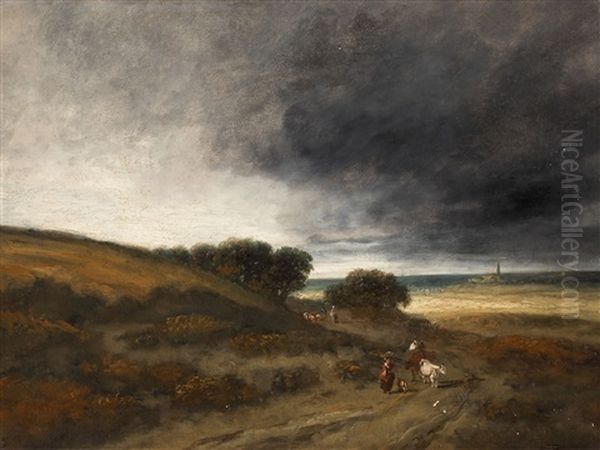
Among Georges Michel's most characteristic and recognized works are paintings that exemplify his focus on the Parisian landscape and his dramatic, Dutch-influenced style. The Mill of Montmartre (circa 1820s), housed in the Metropolitan Museum of Art, New York, is a quintessential Michel piece, depicting one of the iconic windmills of the Montmartre hill against a vast, cloud-filled sky, showcasing his mastery of light and atmosphere.
Another significant work is Storm over the Seine Valley (L'Orage sur la vallée de la Seine), painted between 1820 and 1830 and now in the collection of the Musée des Beaux-Arts de Lyon. This painting powerfully conveys the turbulent energy of nature, a theme recurrent in his oeuvre, heavily indebted to Ruisdael's storm scenes. Other works capture quieter moments, depicting winding roads through wooded areas or panoramic views across the plains surrounding Paris under varying conditions of light and weather.
His paintings are now held in major museum collections across the world, affirming his rediscovered status. Besides the Metropolitan Museum and the Lyon Museum of Fine Arts, his works can be found in the Louvre Museum and the Musée d'Orsay in Paris, the Victoria and Albert Museum in London, the Portland Art Museum, and numerous other institutions in France, Europe, and North America. This widespread institutional recognition contrasts sharply with the neglect he experienced during his lifetime.
Conclusion: A Bridge Between Traditions
Georges Michel occupies a unique and vital position in the history of French art. He served as a crucial bridge, connecting the legacy of 17th-century Dutch naturalism with the burgeoning movement towards Realism in 19th-century French landscape painting. Working largely outside the academic system and achieving little fame in his day, he nonetheless pursued a singular vision focused on the unpretentious beauty and atmospheric drama of the landscapes surrounding Paris.
His dedication to direct observation, his profound understanding and adaptation of Dutch techniques, and his focus on local scenery made him an essential forerunner of the Barbizon School. Though overshadowed for many years, his work now stands as a testament to an independent spirit who anticipated the modern approach to landscape painting. Georges Michel's evocative depictions of the Île-de-France continue to resonate, offering powerful glimpses into the natural world as seen through the eyes of a true pioneer.